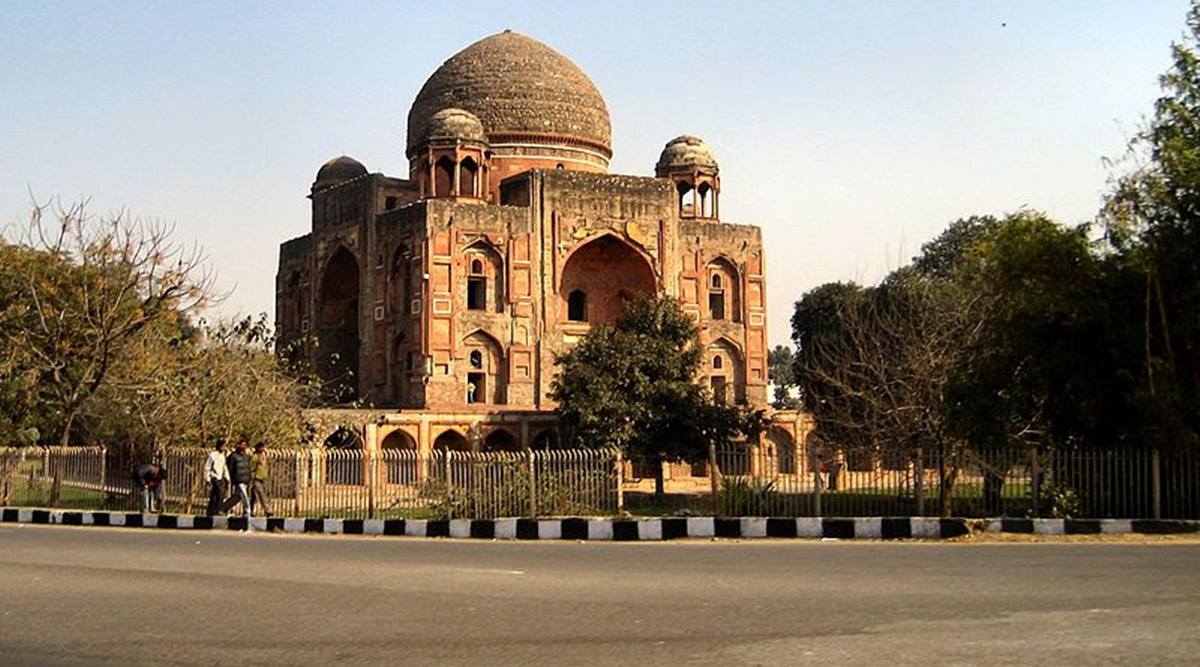 It is said that the monument’s double dome was originally clad with marble, which is said to have been quarried from here for use in Safdarjung’s tomb in the mid-18th century.
It is said that the monument’s double dome was originally clad with marble, which is said to have been quarried from here for use in Safdarjung’s tomb in the mid-18th century.Five decades before the Taj Mahal was built by Shah Jahan, it was Abdur Rahim Khan-e-Khanan — commander-in-chief of Akbar’s army, and a poet — who built a tomb in Delhi in memory of his wife Mah Banu. It was the first Mughal tomb built for a woman. After his death in 1627, Rahim was also buried beside his wife, just like Shah Jahan was in the Taj.
As Rahim Khan’s tomb was opened to the public earlier this week after six years of restoration work — perhaps the largest conservation project ever undertaken for any monument of national importance in India — comparisons with the Taj as one set foot inside were inevitable. While the latter attained glory and became the most sought-after monument in the country, Rahim’s tomb, which inspired the architecture of the Taj, stood alone and faded from public memory.
But in its state of shambles, it carries another piece of historical trivia. The monument came to be used as a quarry in the 18th-19th Centuries — stones from here were plundered to construct monuments elsewhere in the city, such as the Safdarjung Tomb — leaving the structure at a risk of collapse. In fact, in the 1920s, the Archaeological Survey of India (ASI) provided masonry support to overhanging sandstone blocks on the facade, saving the structure from collapsing on itself.
In 2014, the InterGlobe Foundation came on board with the Aga Khan Trust for Culture (AKTC) to support the “conservation of Rahim’s mausoleum”. Intense discussions with the ASI led to the approval of a final conservation plan. “The monument was at risk of immediate collapse at the time,” said Ratish Nanda, CEO of AKTC.
The physical revival included repairs to major damaged structures in the interior and exterior of the mausoleum, its canopies, dome and facade. The landscape around Rahim’s tomb has also been restored to its original slopes and height. “It was clear from the onset that conservation work will be coupled with research, publications, festivals on Rahim’s cultural legacy. So, a team was established to research Rahim’s cultural legacy — his poetry, writings, association with Bhakti poets and, of course, his prowess with the sword,” said Nanda.
Over 3,000 individual craftsmen, including stone carvers, masons and lime plasterers, are estimated to have spent 1.75 lakh hours on this massive conservation effort.
But Nanda says supervision is critical in conservation work, and at Rahim’s mausoleum, it was even more critical as the intricate ornamentation needed to be restored and the condition of the building required complex underpinning of foundations and stitching of cracks.
The six years that followed were part obstacles, part discoveries. Even as AKTC wanted to cover the entire dome with marble and restore it to its original glory, the ASI allowed only partial marble cladding. The 11-member ASI core committee, chaired by then Additional Director General BR Mani, had mandated that only 10 per cent of the dome could be covered with marble, while the rest had to be left as it is. Said Mani, “If the entire dome is covered with marble now, it may amount to retouching history.”
The journey also shed more light on Rahim’s personality — no two patterns or medallions were alike. Just like his dohas, even on the mausoleum, he used Hindu motifs — demonstrating his significant understanding of Hinduism. “Rahim’s persona as a hydraulic engineer — he had built the water supply system in Burhanpur — was demonstrated here as well, when we discovered a fountain that lifted water over 20 feet high (from the pool on the sandstone terrace of the mausoleum),” said Nanda.
Also, texts revealed that the enclosed garden in which the mausoleum stood stretched all the way to the Humayun’s Tomb complex, which is now lost forever. Till now, the monument lacked a dignified entrance, which has now been moved along Mathura Road, to encourage more visitors. The entry ticket has been fixed at Rs 40 by ASI.